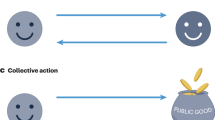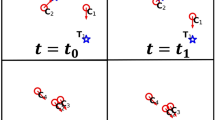Summary
The evolution of cooperation requires either (a) nonrandom interactions, such that cooperators preferentially interact with other cooperators, or (b) conditional behaviors, such that individuals act cooperatively primarily towards other cooperators. Although these conditions can be met without assuming sophisticated animal cognition, they are more likely to be met if animals can remember individuals with whom they have interacted, associate past interactions with these individuals, and base future behavior on this information. Here we show that guppies (Poecilia reticulata), in the context of predator inspection behavior, can identify and remember (for at least 4 h) the “more cooperative” among two conspecifics and subsequently choose to be near these individuals in future encounters.
Similar content being viewed by others
References
Axelrod R, Hamilton WD (1981) The evolution of cooperation. Science 211:1390–1396
Axelrod R (1984) The evolution of cooperation. Basic Books
Barnard CJ, Burk T (1979) Dominance hierarchies and the evolution of “individual recognition”. J Theor Biol 81:65–73
Bernstein I (1981) Dominance: the baby and the bathwater. Behav Brain Sci 4:419–457
Boorman S, Levitt P (1973) A frequency-dependent natural selection model for the evolution of social cooperation networks. Proc Natl Acad Sci USA 70:187–189
Dugatkin LA (1988) Do guppies play TIT FOR TAT during predator inspection visits? Behav Ecol Sociobiol 23:395–399
Dugatkin LA, Wilson DS (1991) ROVER: a strategy for exploiting cooperators in a patchy environment. Am Nat (in press)
Dugatkin LA (1991) Predator inspection, TIT FOR TAT and shoaling; a comment on Masters and Waite. Anim Behav (in press)
Endler J (1987) Predation, light intensity and courtship behavior in the guppy (Poecilia reticulata). Anim Behav 35:1376–1396
Fagen R (1980) When doves conspire: evolution of non-damaging fighting tactics in a non-random encounter animal conflict model. Am Nat 115:858–869
Feldman M, Thomas E (1987) Behavior dependent contexts for the repeated plays of the Prisoner's Dilemma II: dynamical aspects of the evolution of cooperation. J Theo Biol 128:297–315
Hamilton WD (1964) The genetical evolution of social behavior, I and II. J Theor Biol 7:1–52
Lazarus J, Metcalfe N (1990) TIT FOR TAT cooperation in sticklebacks: a critique of Milinski. Anim Behav 39:987–989
Leshner A (1978) An introduction to behavioral endocrinology. Oxford University Press, Oxford
Licht T (1989) Discriminating between hungry and satiated predators: the response of guppies from high and low predation sites. Ethology 82:238–243
Magurran A, Girling S (1986) Predator recognition and response habituation in shoaling minnows. Anim Behav 34: 510–518
Magurran A, Higgam A (1988) Information transfer across fish shoals under predator threat. Ethology 78:153–158
Magurran A, Pitcher TJ (1987) Provenance, shoal size and the sociobiology of predator evasion in minnow shoals. Proc R Soc London, Ser B 229:439–465
Masters M, Waite T (1990) TIT FOR TAT during predator inspection or shoaling? Anim Behav 39:603–605
Maynard Smith J (1982) Evolution and the theory of games. Cambridge University Press, Cambridge
Michod R, Sanderson M (1985) Behavioral structure and the evolution of cooperation. In: Greenwood J, Slatkin M (eds) Evolution — essays in honor of John Maynard Smith. Cambridge University Press, Cambridge, pp 95–104
Milinski M (1987) TIT FOR TAT and the evolution of cooperation in sticklebacks. Nature 325:433–435
Milinski M (1990) No alternative to TIT FOR TAT in sticklebacks. Anim Behav 39:989–991
Pitcher TJ, Green D, Magurran A (1986) Dicing with death: predator inspection behavior. J Fish Biol 28:438–448
Author information
Authors and Affiliations
Additional information
Offprint requests to: L.A. Dugatkin
Rights and permissions
About this article
Cite this article
Dugatkin, L.A., Alfieri, M. Guppies and the TIT FOR TAT strategy: preference based on past interaction. Behav Ecol Sociobiol 28, 243–246 (1991). https://doi.org/10.1007/BF00175096
Received:
Accepted:
Issue Date:
DOI: https://doi.org/10.1007/BF00175096




